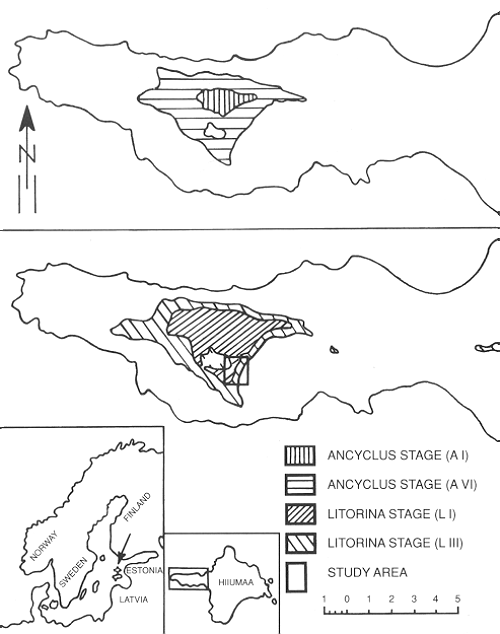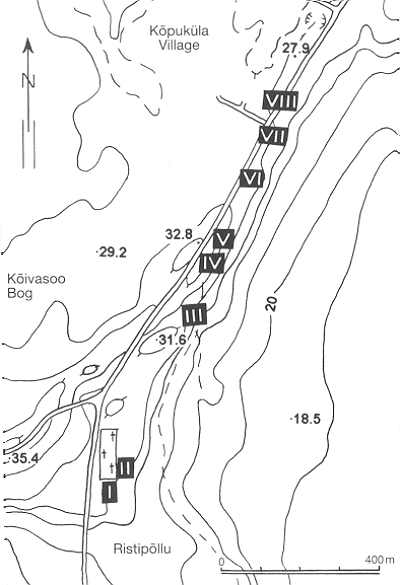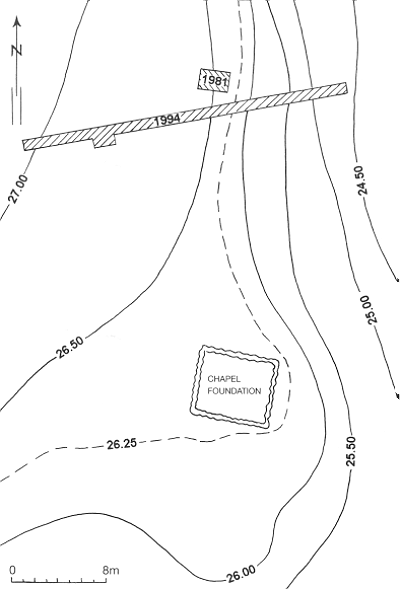COASTAL ADAPTION AND MARINE EXPLOITATION OF THE
ISLAND HIIUMAA, ESTONIA, DURING THE STONE AGE WITH SPECIAL EMPHASIS ON
THE KÕPU I SITE
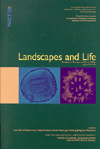
Lembi Lõugas, Aivar Kriiska and Harri Moora Published: Landscape and Life. Studies in honour of Urve Miller.
PACT 50, Rixensart 1996, 197–211
Abstract
INTRODUCTION The island, Hiiumaa, is one of the
archaeologically less studied areas in Estonia. The better investigated
antiquities of the area are stone-cist graves from the Iron Age. Up until
1981 only some stray finds from the Stone Age were known from Hiiumaa (Lõugas
and Selirand, 1989).
During the excavations of the Pre-Roman
stone-cist graves at the village of Kõpu in 1981, an archaeological
inventory was carried out in the surrounding area. Vello Lõugas,
the leader of these excavations, found a new site in the Ristipõllu
farmstead, in the village of Ülendi (V. Lõugas, 1982, 1993).
Already, that year, an area of 2 x 3.5 m was excavated and one fireplace
with a diameter of 1.5 m was studied. A fragment of a stone axe, a flint
scraper, some quartz artefacts, quartz and flint pieces, a piece of the
Baltic red-quartz-porphyry and a small number of animal bone remains were
found (V. Lõugas, 1982). Charcoal from the fireplace was radiocarbon
dated to 5330±90 BP : TA-1493 (V. Lõugas, 1993). The absence
of Neolithic ceramics from this excavation area was the main reason for
the opinion at that time, that the site was used during the Late Mesolithic
period.
In 1993, the question of the necessity
for further investigation of the Stone Age sites on the Kõpu Peninsula,
involving interdisciplinary collaboration between archaeologists, geologists
and biologists, was raised. As a result new excavations were planned within
the framework of a project on the Estonian Stone Age coastal habitation,
geology and fauna. This is also part of the PACT palaeoenvironmental research.
The aim of these excavations was
to obtain new and exact datings for the appearance of the early inhabitants
of the island, to find more evidence relevant to the history of marine
vertebrates and to classify more precisely stratigraphic and topographic
situation of the site. GEOLOGICAL BACKGROUND Kõpu is the largest and most westerly peninsula of the Hiiumaa island. The peninsula is approximately 20 km long from west to east, with a width ranging between 3.5 and 7.3 km (Fig. 1). Morphologically the Kõpu Peninsula can be described as a central upland surrounded by planes on the east, south and west. This upland lies at a height of 44–46 m and rises in its south-western part to 59–62 m above the present sea level. The highest point of the peninsula — Tornimägi — at 66.2 m a.s.l. is also situated here. Other areas of high altitude are the dunes located to the east and south-west of the central upland (St. Andreas Hill, 63.0 m a.s.l.).
Fig. 1. Location of the island, Hiiumaa and development of the Kõpu Peninsula. The upper part of the central upland
of Kõpu can be described as a big glacial erratic, consisting of
tills, which has been transported here by the continental ice at the time
of the Palivere stadial of the Weichselian glaciation (Eltermann, 1993).
Later, this part of the central upland with older till beds and limnoglacial
sediments of the Pandivere stadial was covered by fluvioglacial and other
glaciolacustrine deposits left behind by the retreating glacier. This resulted
in a ridge-like landform running from east to west with several smaller
branches. The soft erodable Quaternary deposits have been partly reshaped
by the waves of the ancient stages of the Baltic Sea. Thus, there is an
abundance of both accumulative (beach ridges) and erosional (bluffs) coastal
formations.
The Kõpu Peninsula was the
first part of Hiiumaa to emerge from the sea as a small island about 10,300
years ago. Today, the highest shorelines of this island, which are related
to the Baltic Ice Lake Stage, can be found between 53 and 62 m.
Kents (1939) separated the Ancylus
Lake and the Litorina Sea bluffs into 10 different series and the Ancylus
Lake coastal ridge into 12 series (see also Raukas and Ratas, 1995). At
the time of regression, which followed the maximum of the Ancylus transgression
and especially during the catastrophical lowering at the end of the Ancylus
Stage — A VI (Kessel and Raukas, 1967), the land emerged from
the water step by step primarily from the south, west and east of its original
point of emergence (Fig. 1). A bay, later a lagoon, was formed, at what
is presently known as the Kõivasoo Bog, bordered with coastal ridges
of the Ancylus Lake. At the end of the Ancylus regression the water level
in the Kõpu area dropped to as low as 20 m a.s.l. (Raukas and Ratas,
1995) and thus, for some time, this bay became a lake isolated from the
sea.
Evidence of the Mastogloia/Litorina
transgression is found earlier in Hiiumaa than in other parts of Estonia
(Kessel and Raukas, 1967). As a result of the rising water level a lagoonal
lake existed once again at Kõivasoo Bog (Sarv et al., 1982).
During the following regressive phases of the Litorina Sea, the island
of Kõpu grew remarkably in size (Fig. 1). Kents (1939) established
the Litorina beach ridges and bluffs at a height of 15–27 m a.s.l.
This is supported by the 1994 field work findings of a brackish water subfossil
mollusc fauna (identified by E. Tavast) Cerastoderma glaucum, Hydrobia
ulvae, Littorina litorea and Scrobicularia plana (at 26 m a.s.l.) in
the ridge located at the Kõpu I site as well as by findings of a
typical Ancylus fresh water mollusc fauna Lymnea baltica, Ancylus fluviatilis,
Lymnea palustris, Pisidium amnicum and Anisus contortus (at 30 to 32
m a.s.l.) at the village of Kõpuküla. This confirms that the
maximum level of the Litorina Sea was more than 26 m above the present
sea level, but not as high as 30 m a.s.l.
Around 4800 BP the Kõivasoo
Lake became a fen (Sarv et al., 1982). Also, at this time, the intensive
formation of dunes began.
During the last 4000 years, the time
of the Limnea Sea stage, the regression of the Baltic Sea has continued.
The coastal formations of this time can be found at 15 metres or less above
the present sea level. At the beginning of the Limnea Sea stage (Lim I–II)
a connection formed between Kõpu Island and Hiiumaa. NATURAL CONDITIONS AND EARLY INHABITANTS OF THE ANCIENT KÕPU ISLAND The first plant immigrants to the
island could have been spread by seed eating birds and/or by the wind.
In the beginning, shrubs probably dominated the flora of the island while the
spread of trees was slower.
It seems likely that by the time
hunters and fishers first appeared on the island in the Late Mesolithic
and/or the Early Neolithic period the flora was already quite diverse.
According to Sarv et al. (1982), alder, hazel, pine and lime were
the dominant species of trees at that time.
An increase in the salinity of water
during the beginning of the Litorina Stage allowed an abundence of marine
fauna to develop in the Baltic and consequently an increasing interest
for people to inhabitat the island. The southern coast of the ancient Kõpu
Island offered more favorable conditions for prehistoric seal hunters than
the steeper northern coast. Therefore, there are numerous Stone Age sites
on the coastal ridges of the Ancylus regression and the Litorina transgression
in that region (Fig. 2).
Fig. 2. Study area with Kõpu I–VIII Stone Age sites.
ARCHAEOLOGICAL EVIDENCE New excavations were carried out
at Kõpu I in July/ August, 1994. A 32 m long and 1 m wide trench
with one extension 1 x 2 m (Fig. 2 and 3) cut the ancient coastal ridge
almost at right angles. The trench was so positioned to give maximum information
of the stratigraphy of the site and the range of the cultural layer at
that place.
Since the area had been used as a
field for quite a long time, the uppermost layer (25–30 cm) was
mixed. Under the mixed layer there was an untouched cultural layer characterized
by a lightly dirty (cinder) soil with distinct black fireplaces. The cultural
layer started at a height of 26.5 m a.s.l., but continued to the west of
the excavated trench, i.e. more than 27 m a.s.l. (see Fig. 3).
Altogether seven fireplaces have
been found. All these were surrounded with stones and deepened into the
natural ground level. The strongly swollen and crumbled granite stones
and the dark cinder soil indicate intensive fire making. The diameter of
the fireplaces was mostly 0.6–1.3 m. Only two fireplaces were
represented by an oval stone pit.
Fig. 3. Location of the excavation area of the Kõpu I site at Ristipõllu. Ceramics About 500 fragments of pottery have
been found from the site excavated in 1994. Stone rubble dominated in the
temper of ceramics, i.e. it occured in the composition of 90 % of
the fragments. Most of the stone rubble has been mixed with some organic
matter which was burnt out, and the only evidence of usage of the latter
is the porosity and lightness of the fragments. Some potsherds seem to
have an organic supplement. It is not clear, however, whether the organic
matter was added to the clay body or whether the clay was taken from upper
layers together with roots.
The pottery was made by the coiling
technique. The coils are connected to each other by the U-principle; one
of the junction edges of the clay coil is convex and the other is concave
(Fig. 4 : 1, 2 and 3). The clay coils are quite narrow, about 0.7–2.3
cm (86 % of the coils are less than 2 cm).
The walls of the vessels are rather
thick: about 6–13 mm. Since the ceramics have been preserved only
in small pieces, a reconstruction of the shape of the vessels is impossible.
We can only assume that the pots had a conical shape with a pointed or
rounded bottom.
The surfaces of the vessels are mostly
smoothed, but about 5 % of the fragments have been striated. The striae
are narrow, 1–2 mm wide. Only one fragment has a wider striae,
up to 4 mm. 2.5 % of potsherds are ornamented. Mostly there are notches
of approximately one millimetre on the surface, but two fragments have
a grooved ornament and one has a pit with of 4 mm diametre which nearly
penetrates the vessel wall.
The ceramics from the Kõpu
I site are peculiar among the Early Neolithic pottery in Estonia. Some
of the technological parameters indicate Narva Type ceramics, such as the
occurrence of organic matter in the clay body. More characteristic is the
construction technique, i.e. the U-principle which occurs frequently
around the estuary of the Narva river, in east Estonia (Gurina, 1967; Kriiska,
1994). More than 2/3 of the Narva Type ceramics from this region are made
by the U-technique. An essential difference between the pottery on the
Estonian mainland and at Hiiumaa is the occurrence of stone rubble in the
Kõpu ceramics. A mineral supplement is also characteristic of the
Early Neolithic pottery found at the Kõnnu site, Saaremaa (Jaanits,
1979).
The surface finish and the ornaments
of the Kõpu ceramics are quite similar to the Narva Type pottery,
but the similarity with the Kõnnu ceramics is greater. Characteristic
of the latter is a scarcity of ornamentation and the presence of grooves
and comb impressions. A feature typical of the ceramics of Kõpu
and Kõnnu is the occurrence of small pits, which nearly penetrate
the walls of the vessels (Jaanits, 1984). Artefacts 4349 stone bits, stone artefacts
and fragments have been gathered from the Kõpu I site. 3475 of them
are quartz, rarely quartzite, fragments (Fig. 4:5) or artefacts, 687 flint
stone bits or artefacts, 144 stone fragments and 43 sandstone splinters
(i.e. mainly small polishstone fragments).
The majority of the finds are manufacturing
remains and differed in size. About 30 quartz scrapers (Fig. 4:8) are characterized
by an oval point which thickens to an opposing straight edge. There are
some triangular and trapezium-shaped scrapers in the material as well.
Some quartz and quartzite knives (Fig. 4:10), quartz bores (Fig. 4:9)
and quartz burins (Fig. 4:11) were found. Among the latter, there are two
pieces which have beak-shaped points (Fig. 4:11). Similar burins are known
from the Kääpa site, south-east Estonia (Jaanits, 1968). 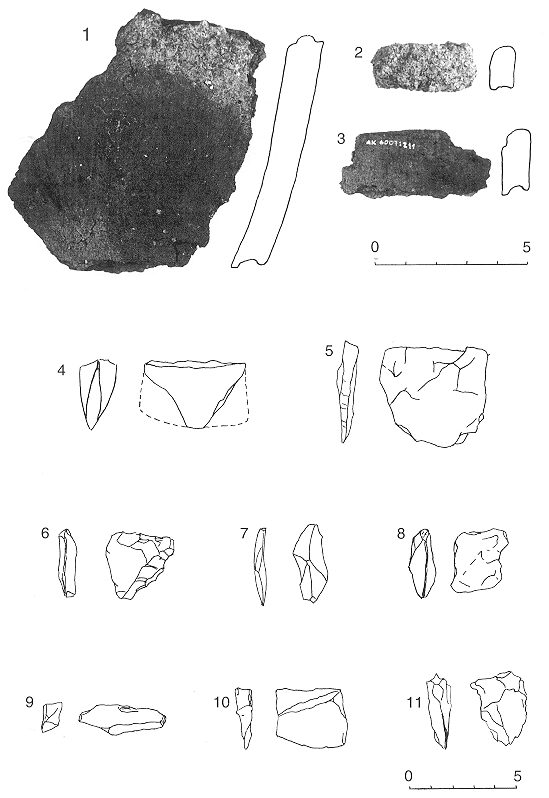
Fig. 4. Archaeological finds from the Kõpu I site. 1 – AI 6007:424; 2 – AI 6007:260; 3 – AI 6007:211; 4 – AI 6007:66; 5 – AI 6007:78; 6 – AI 6007:313; 7 – AI 6007:75; 8 – AI 6007:68; 9 – AI 6007:68; 10 – AI 6007:130; 11 – AI 6007:68. The flint stone was white or grey
and of bad quality. The flint stone is mostly in the form of fragments.
There are some scrapers (Fig. 4:6) and slivers (Fig. 4:7) in the material.
Only one chisel fragment has been
found (Fig. 4:4). Originally the edge could have been about 5 cm. This
find came from the mixed ploughed layer. From the same layer an elongated
oval stone object with two hitting marks was extracted. It could have been
used as weight.
Splinters of crystalline rock and
one sliver were also found. Among these the fragments of Baltic red quartz-porphyry
are the more interesting. The use of the latter was common in Saaremaa
in the Stone Age. NEWLY FOUND STONE AGE SITES IN KÕPU Inventories were made at Kõpu
in 1994, including the scanning of ancient shorelines between 25 and 30
m a.s.l. Seven new places were found within the distance of 1 km (Fig.
2). The cultural layer was hardly distinguishable — darker soil
occurred only in the fireplaces and finds were from a slightly cindery
soil. 1.5 x 2.0 m trial pits were excavated at point VIII (Fig. 2). This
site contains a lot of quartz fragments and objects, flint and polishstone
fragments. At site IV (Fig. 2) the cultural layer is situated beneath a
dune and, after the removal of the sand, one fireplace with stones covering
1.5 x 2.0 m was found. No ceramics were found in these sites. We can only
assume that points IV and VIII, which are situated at 28–30 m
a.s.l., could be derived from the pre-ceramics period.
DATING OF THE SITES Often the archaeological finds do
not allow an exact determination of the age of a site. According to the
Estonian division of prehistoric periods, in which the Neolithic starts
with the use of pottery (Jaanits et al. 1982), the absence of ceramics
above a height of 27 m at Kõpu (Kõpu IV and VIII) suggests
that these places were used in the Late Mesolithic. Alternatively, the
absence of ceramics may be explained by the fact that people did not take
many vessels with them to a site which they used only seasonally. They
returned to their base camp with pots full of oil and no pieces of ceramic
were left behind on the island. More exact determinations can only be obtained
by using a combination of different dating methods. For example, ceramic
finds coupled with radiocarbon dates which indicate the Neolithic, or an
absence of ceramics, but older 14C ages
which indicate the Mesolithic and so on.
Some new radiocarbon datings were
made on charcoal from Kõpu site I in 1994. The results are shown
in Table I. On the basis of these we can conclude that the Kõpu
I site represents the Early Neolithic Narva culture. TABLE I. RADIOCARBON DATES (FROM CHARCOAL) FROM KÕPU SITE I.
ARCHAEO-ZOOLOGICAL STUDIES All soil excavated from Kõpu
site I was sieved with 1 and 2 mm hand-sieves. Altogether 3618 bone fragments
were analysed or counted. Macromammal bone fragments smaller than c. 0.5
cm² are not included here. About 24 % of the bones were burnt. Of
the total material there were only 549 fragments which could be successfully
identified to species or as seal bone.
The results of the bone analyses
show that the greater part of the animal remains come from seals, and that
only the ringed seal (Pusa hispida) and the grey seal (Halichoerus
grypus) were hunted (Table II). The former is represented by 54 fragments
from a minimum of 6 individuals and the latter by 45 fragments from 4 individuals.
Bad preservation conditions in the sandy and stony soil prevented the identification
of a large number of seal bones (433).
Large numbers of seal bones are typical
of Neolithic coastal sites around the Baltic Sea (Forstén and Alhonen,
1975; Ericson, 1989; Lepiksaar, 1986). Four species of seal have been found
from the coastal area of Estonia in different prehistoric periods. These
are the grey seal, the ringed seal, the harbour seal and the harp seal
(Lepiksaar, 1940; Tsalkin, 1952; Paaver, 1965; L. Lõugas, 1992,
1993, 1994). The latter species was more common at the end of the Neolithic
(Subboreal climatic period) and probably entered the Baltic seasonally
during its southward migration in autumn (Lepiksaar, 1986; Lõugas,
in press). The absence of harp seal remains in the material of the Kõpu
I site (also the Kõnnu site on the island of Saaremaa) is not a
surprise, because the oldest finds of this species in the Baltic, from
the island of Gotland, Sweden, are dated by radiocarbon method to 5245±60
BP and 5020±60 BP (Lindqvist and Possnert, in press) and/or the
hunting season and technique for the harp seal differed from that of the
ringed seal and grey seal.
The hedgehog (Erinaceus europaeus)
is a very interestig find, because this species cannot populate isolated
islands by itself. The hedgehog must have carried a magic meaning for prehistoric
people. These 4 mandible fragments (Table II), found from a fireplace at
the site, could have been brought to the island with the skin or as part
of a complete skull. The site seems to have been used only during the seal
hunting season, in early spring, when the hedgehog is in hibernation. It
is, therefore, doubtful that a living animal had been brought to the site. TABLE II. NUMBER OF FRAGMENTS AND MINIMUM NUMBER OF INDIVIDUALS AMONG THE ANIMAL SPECIES FOUND FROM THE ARCHAEO-ZOOLOGICAL MATERIAL OF THE KÕPU I SITE.
Bird bones were very badly preserved
and in the form of small fragments. The location of the ancient Kõpu
Island was very favourable for birds of passage as a resting place during
their south-north migrations. This island, with a lake (later a bog) in
its centre (Fig. 1), offered good conditions, especially for water birds.
Probably a lot of ducks and gulls nested on the island and hunters were
able to use their eggs for food in the spring. The remains of eider (Somateria
mollissima), ducks (Clangula hyemalis and/or Bucephala clangula),
cormorant (Phalacrocorax carbo) and red-breasted merganser (Mergus
serrator) provide evidence of water bird hunting. One phalanx
of the white-tailed eagle (Haliaëtus albicilla) has been found,
but this is not sufficient to prove the hunting of this species on the
island because the leg of the bird could be used in some ritual ceremony.
Even though all the excavated soil
was sieved, very few fish species were represented in the bone material:
only pike (Esox lucius), cod (Gadus morhua) and turbot (Scophthalmus
maximus). The finds of cod and turbot indicate the existence of Atlantic
forms in Estonian waters already at that time. The small amount of fish
remains could be the result of bad preservation conditions or could indicate
the absence of fishing among the prehistoric settlers of Kõpu. The
main reason for coming to the island was most likely seal hunting. It is
also possible that the few fragments of fish bone came from the entrails
of seals.
There is some evidence that the Kõpu
I site (probably all the sites I–VIII) was used only at a certain
season of the year — in early spring. Firstly, this time is best
for hunting the grey and ringed seal. One subfossil femur of the ringed
seal was the same size as the femur of a recent individual weighing about
10 kg. This specimen could be only a few days, at maximum a week, old and
so must have been hunted at the end of March or beginning of April. Secondly,
the possibilty of using the site throughout the year is quite doubtful,
because the island was only about 5 km² in size, 80 km from the mainland
and 40 km from Saaremaa, and did not offer any good food possibilities,
except for fish and seal, which are usually seasonal food. The hazelnut
shells and some bigger tubular bone fragments (elk and/or wild boar ?),
which were recovered from the Kõpu I site, seem to have been brought
to the island by people. It is possible that the hazelnuts are local, but
the distribution of big terrestrial mammals to such a small, isolated island,
where the relevant ecological niche is limited, is almost impossible.
One seasonal dating method is based
on fish vertebrae. The annual rings allow a determination of the approximate
season in which the fish died (Casteel, 1976). The annuli on the vertebral
centrum of pike and turbot (both were 3 years old) from Kõpu I indicated
that the fish had been caught in March or April. DISCUSSION The study of the Stone Age habitation
of the Kõpu Peninsula is in its initial stages and so these conclusions
are only preliminary. It is evident that the southernmost coastal part
of the peninsula was used for quite a long time, from the Late Mesolithic
to the Early Neolithic. A thin cultural layer, the monotonous nature of
the find material, the scarcity of hewing equipment, an absence of middens
and a lot of seal remains indicates the seasonal use of the site by seal
hunters. Mesolithic and Early Neolithic finds are quite similar, both with
respect to the type of material and the objects. Possibly, people came
to the island from a certain region to hunt seals, and successive generations
have returned to the same place for thousands of years to hunt seals in
the main season.
The southernmost part of the ancient
Kõpu Island was a strategically favourable place for seal hunters.
A gently sloping coast offered better resting and also breeding conditions
for seals in winters of pure ice formation (typical of the Atlantic period)
than the north coast of the island. At the time of existence of the Kõpu
I site sea level was approximately at a height of 20–22 m above
the present sea level (Fig. 2 and 3). The hunters chose their stopping
place on the higher (25–27 m a.s.l.) dry beach ridge.
The ceramics from Kõpu I help
us to explain the cultural origin of the prehistoric settlers. In general
lines the fragments of pottery belong to the same group as the Narva Type
ceramics. More similarities are noticed with Kõnnu ceramics from
Saaremaa. Probably the sites at Kõnnu and Kõpu represent
some kind of local phenomenon of the Narva Culture. The seal hunters who
stopped on the Kõpu Peninsula may have come from Saaremaa or from
the West Estonian mainland, but we do not know yet of Early Neolithic sites
from the latter region. ACKNOWLEDGEMENTS We would like to thank Professor
Urve Miller of the Department of Quaternary Research, Stockholm University,
for her kind support and help in interdisciplinary research involving archaeology
and the natural sciences. We also thank Dr Tanel Moora, Institute of History,
Estonian Academy of Sciences, for valuable discussion and help with the
field work, Dr Vello Lõugas (same institution) for discussion, Jana
Ratas, Art University, Tallinn, for drawing the figures, Dr Elvi Tavast,
Institute of Geology, Estonian Academy of Sciences, for analysing the malacofauna,
Dr Shiela Hicks, Oulu University, for linguistic revision, Dr. Christian
Lindqvist, Stockholm University, for participation in the excavations and
discussions, and all students of Tartu University who took part in the
archaeological excavations in Kõpu in 1994.
During this investigation, all of
us were researchers on a grant (No. 1022) provided by the Estonian Scientific
Foundation. The Institute of History, Tallinn, partially supported these
excavations in the summer of 1994 and during later studies. Lembi Lõugas
also thanks the Nordic Council of Ministers for financial help during her
studies in Sweden and Dr Leif Jonsson, Gothenburg, for help with the bird
bone determinations.
REFERENCES
CASTEEL, R.W., 1976,
Fish Remains in Archaeology and Palaeoenvironmental Studies, London,
180 p.
ELTERMANN, G., 1993,
Hiiumaa geoloogi pilguga, in Eesti Loodus, 3, p. 103–105.
ERICSON, P., 1989, Säl och säljakt I Östersjöområdet
under stenåldern, in Report Series, Lund University, 33, p.
57–64.
FORSTÉN, A. and ALHONEN, P., 1975, The Subfossil Seals of Finland and
their Relations to the History of the Baltic Sea, in Boreas, 4, p.
143–155.
GURINA, N.N., 1967, Iz istorii drevnich plemen zapadnych oblastei SSSR, in
Materialy i issledovanija po arheologii SSSR, Moskva-Leningrad, 205 p. (in
Russian).
JAANITS, L., 1968, Die frühneolithische Kultur in Estland, in
Congressus Secundus Internationalis Fenno-Ugristarum Helsingiae habitus 23.–28. VII
1965, Pars 2, p. 12–25.
JAANITS, L., 1979, Die neolithische Siedlung Kõnnu auf Insel
Saaremaa, in Eesti Teaduste Akadeemia Toimetised, Ühiskonnateadused, 4, p.
363–367.
JAANITS, L., 1984, Ranneneolititscheskie kulturnyje gruppy v Estonii, in
Doklady Tretego sovetsko-finljandskogo simpioziuma po voprosam arheologii 11.–15.
maja 1981, Leningrad, p. 16–21, (in Russian).
KENTS, P., 1939, Postglatsiaalsed
Läänemere randjoone võnkumised Eestis illustreeritud Kõpu
poolsaarel, Tartu University, 61 p.
KESSEL, H. and RAUKAS,
A., 1967, The Deposits of the Ancylus Lake and Litorina Sea in Estonia,
Valgus, Tallinn, 135 p. (in Russian with English summary).
KRIISKA, A., 1994,
Narva jõe alamjooksu ala neoliitiline keraamika, Magister
dissertation, Tartu University, 99 p.
LEPIKSAAR, J., 1940,
Grööni hüljesest, Phoca groenlandica, Erxl., Läänemeres,
tema uue leiu puhul pronksiaegsest asulast Asvas, Saaremaal, in Eesti
Loodus, 2, p. 87–90.
LEPIKSAAR, J., 1986,
The Holocene History of Theriofauna in Fennoskandia and Baltic Countries,
in Striae, 24, p. 51–70.
LINDQVIST, C. and POSSNERT,
G., in press, The Subsistance Economy and Diet at Jakobs/Ajvide and
Stora Förvar, Eksta Parish and other Prehistoric Sites on Gotland
in Long-Term Perspective, in Theses and Papers in North-European
Archaeology, 13, Department of Archaeology, Stockholm University.
LÕUGAS, L.,
1992, Subfossil Seals from Archaeological Site of Asva in Saaremaa,
in Proceedings of the I Baltic Theriological Conference, Tartu Ülikooli
Toimetised, 955, p. 163–170.
LÕUGAS, L.,
1993, Kui grööni hüljes elas Läänemeres,
in Eesti Loodus, 3, p. 83–84.
LÕUGAS, L.,
1994. Subfossil Vertebrate Fauna of Asva Site, Saaremaa. Mammals,
in Reports of the Estonian Archaeological Society, Stilus, 5, p.
71–93.
LÕUGAS, L.,
in press, Subfossil Seal Finds from Archaeological Coastal sites in
Estonia, East Part of the Baltic Sea, in Anthropozoologica,
Paris.
LÕUGAS, V.,
1982, Beiträge zur Vorgeschichte des Westarchipels Estlands,
in Eesti Teaduste Akadeemia Toimetised, Ühiskonnateadused,
4, p. 372–376.
LÕUGAS, V.,
1993, Aruanne Kõpu "Ristipõllu" kiviaja asulakoha proovikaevamistest
1981.a. (Reigi kih.), in Report of the excavations, Institute
of History, Tallinn.
LÕUGAS, V. and
SELIRAND, J., 1989, Arheoloogiga Eestimaa teedel, Tallinn, 410 p.
PAAVER, K., 1965, Formirovanie
teriofauny i izmencivost mlekopitajuschich Pribaltiki v holocene, Estonian
Academy of Sciences, Tartu, 494 p. (in Russian with German summary).
RAUKAS, A. and RATAS, U., 1995, Holocene Evolution and Palaeoenvironmental
Conditions of Hiiumaa Island, Northwestern Estonia, this volume.
SARV, A., PORK, M.
and ILVES, E., 1982, Stratigraphy and Chronology of Lake and Bog
Deposits of the Kõivasoo Bog, in V. MASING (ed.) Peatland
ecosystems Tallinn, p. 148–163.
TSALKIN, V. I., 1952,
Novye dannye o rasprostranenii grenlandskogo tjulenja, in Bjulleten
Moskovskovo Obschestoo Ispytatelei Prirody. Seria biologia, 62:2, Moskow-Leningrad,
p. 81–83. (in Russian). |
